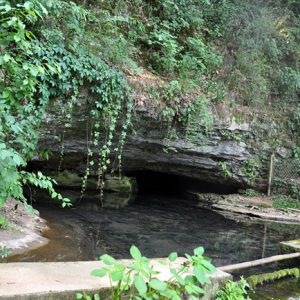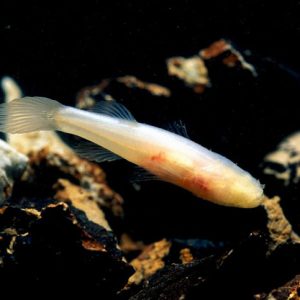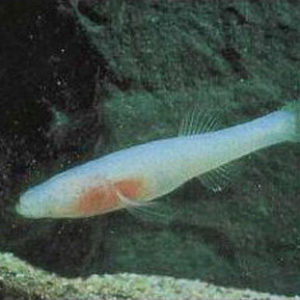calsfoundation@cals.org
Ozark Cavefish
aka: Amblyopsis rosae
The Ozark cavefish (Amblyopsis rosae) is found in the Springfield Plateau of the Ozark Mountains. Its geographic distribution covers approximately 8,200 square miles (21,000 square kilometers), comprising an area drained by the White River on the south and the east, the Neosho River (Arkansas River basin) on the west, and the Osage River (Missouri River basin) to the north. This species has been reported in at least fifty-two caves over three states: Missouri, Arkansas (originally in ten but now in seven sites in Benton County), and northeast Oklahoma. It has been proposed that there are two subspecies of this fish: Amblyopsis rosae whitae for the White River drainage region and Amblyopsis rosae arkansasus for the middle Arkansas River drainage region.
The adults of this species may reach nearly three inches (seventy millimeters) in total length. They have an elongated and broad flattened head, with a projecting lower jaw. The dorsal and anal fins are located far back on the body, the caudal fin is rounded, the pectoral fins are elongated, and the pelvic fins are absent. They have from four to six rows of sensory papillae on the anal fin. The anus migrates forward toward the throat in adults. They have rudimentary eyes hidden under the skin and are depigmented.
Individuals of this species are found mostly in caves near large permanent streams but always in small cave streams with chert or rubble bottom, in pools over silt and sand bottom, or in karst window or wells—but never too deep. The water source is almost always an upwelling from the groundwater table. Suitable caves inhabited by the Ozark cavefish all have a relatively substantial source of nutrients, such as bat guano or blown leaf litter. These fish can tolerate the extremely low oxygen content in the water and have a very low metabolism, spending most of their time motionless in the water. They feed mostly on small crustaceans, but cases of cannibalism have been reported. They may also consume bat guano and leaf litter.
It is believed that the eggs, numbering up to seventy, are carried in the gill chamber of the female until they hatch; the young remain in the gill chamber until the yolk is absorbed, for a period of four to five months. The fish is slow growing, with a long life span (approximately ten years), and maturation takes at least four years.
This species has been classified as vulnerable by the World Conservation Monitoring Centre and as threatened by the U.S. Fish and Wildlife Service. In Arkansas, it has been classified as extremely rare. The population at Cave Springs (Benton County) has recovered from past extensive over-collecting. Because of its low reproductive abilities, restricted habitat, and unresponsive behavior toward captors, the Ozark cavefish is very vulnerable to over-collection and pollution. Some individuals have even been reported in the pet trade. A large scientific collection took place in the 1930s from one Arkansas cave.
As of 2008, recent population counts for this fish at Cave Springs Cave in Benton County showed an increase in the number of individuals. The State of Arkansas purchased Cave Springs Cave, which hosts the largest cavefish population for this species. The Ozark Cavefish Recovery Plan designated this cave as the primary recovery habitat while calling for the protection of caves and recharge areas at Cave Springs and Logan (Benton County).
For additional information:
Noltie, Douglas B., and Carol M. Wicks. “How Hydrogeology Has Shaped the Ecology of Missouri’s Ozark cavefish, Amblyopsis rosae, and southern cavefish, Typhlichthys subterraneus: Insights on the Sightless from Understanding the Underground.” Environmental Biology of Fishes 62 (October 2001): 171–194.
Robison, Henry W., and Thomas M. Buchanan. Fishes of Arkansas. 2nd ed. Fayetteville: University of Arkansas Press, 2020.
Romero, Aldemaro. “Threatened Fishes of the World: Amblyopsis rosae (Eigenmann, 1842) (Amblyopsidae).” Environmental Biology of Fishes 52 (August 1998): 434.
Wicks, Carol M., and Douglas B. Noltie. “Conceptual Models of the Habitat of the Southern and Ozark Cavefishes.” In Geological Society of America National Meeting Abstracts with Program, Toronto, Canada. Vol. 30. Boulder, CO: Geological Society of America, 1998.
Woods, Loren P., and Robert F. Inger. “The Cave, Spring, and Swamp Fishes of the Family Amblyopsidae of Central and Eastern United States.” American Midland Naturalist 58 (July 1957): 232–256.
Aldemaro Romero
Arkansas State University
 Environment
Environment Cave Springs Cave Natural Area
Cave Springs Cave Natural Area  Ozark Cavefish
Ozark Cavefish  Ozark Cavefish
Ozark Cavefish 




Comments
No comments on this entry yet.